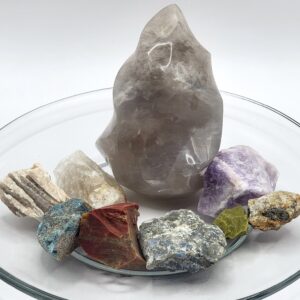Apophyllite Specimen
$87.75
This apophyllite specimen is sure to amaze! It has beautiful double-terminated crystal formations and it is UV reactive. What more can you ask for? This incredible piece would make an excellent gift or be a spectacular addition to any collection.
Only 1 left in stock
Description
Our apophyllite specimen has stunning crystal formations. Among these formations include many double-terminated crystals (DT). Also, this amazing specimen is UV reactive! It weighs about 787g and measures 6.00″ across.
About Apophyllite
Apophyllite is primarily mined in countries such as India, Brazil, and Iceland, where it is found in volcanic rock formations. The chemistry of apophyllite is characterized by its group of minerals known as phyllosilicates, which have a layered structure with tetrahedral sheets of silica connected by oxygen atoms. Apophyllite crystals are composed of hydrated potassium calcium silicate minerals, with the presence of water molecules in their structure contributing to their unique properties. The formation of apophyllite crystals is influenced by the cooling and solidification of volcanic gases and fluids, leading to the growth of these distinct mineral formations.
Did you know that apophyllite is actually a group of minerals? Learn more here.
Double-Terminated Crystals: Hand-Cut or Natural?
How to Tell the Difference
Naturally double-terminated crystals, formed in nature, typically exhibit natural features such as irregularities, growth patterns, and inclusions that are not present in hand-cut crystals. These natural crystals may also have rough or uneven surfaces, and their terminations may not be perfectly symmetrical. In contrast, hand-cut crystals often have more uniform shapes, smooth surfaces, and precise terminations due to the cutting and polishing process. Additionally, hand-cut crystals may show signs of human intervention, such as tool marks or facets, which are not found in naturally occurring double-terminated crystals.
This apophyllite specimen is a WYSIWYG.
For those who are unfamiliar with WYSIWYG, it means: What You See Is What You Get. Pieces identified as WYSIWYGs are not a random pull of stones that are similar to the one(s) pictured. Instead, you receive the actual piece that is pictured.
If you love this specimen, you will love the volcano agate sphere as seen in one of these photos.
Please Note:
- Sizes and weights are approximate. Dimension sizes can vary based on the way the rock is formed. We hand measure our pieces on the longest side. Please see the pictures in the listing.
- The colors may vary due to monitor and lighting differences.
- Please use your own judgment when allowing children to handle.
- Not suggested for use in animal habitats or fish tanks.
- UV Notes: For gemstones, 365nm is the best for UV lighting. Only some specimens illuminate under the other part of this spectrum (370-400nm). This is why some pictures are not as clear for our UV reactive pieces. Our current lights are at 395nm. For home use, the 395nm is less expensive, but in some cases, will need a zoomed beam on the flashlight style UV lights. If you do use a 365nm light, please take care to use eye protection.
Additional information
| Weight | 1.69095 lbs |
|---|
Only logged in customers who have purchased this product may leave a review.













Reviews
There are no reviews yet.